Читать книгу Manage to Engage - Pamela Hackett - Страница 35
No Connections in Range
ОглавлениеOur connectivity levels, a precursor for engagement, are far from ideal. The research shows that people are not willing to invest discretionary effort at work. Our internal sensors are continuously searching for and failing to find a connection, and this is costing businesses billions – in poor productivity, lost profits, accidents, theft, weakening brands, and lost opportunity. It's also costing people their emotional well-being. People feel they are flatlining at work. This disconnect to the world of work is a crisis of epic proportions. Whole populations of underengaged employees are sapping our economies, our health and their own happiness, and ultimately our success as individuals, communities, and even countries. While we know deep down that wellbeing at work affects every aspect of our lives, the answer to improving it remains elusive.
This must change. We cannot come out of a global economic meltdown and health crisis with a workforce feeling this underenthused. We can't change it if they remain that way. After the 2007–2008 financial crisis, our global business environment had fundamentally changed. And it has continued ever since:
1 We must run leaner operations and be more innovative and creative to address business and customer needs concurrently. An attitude of spending money consciously must be built into the fabric of an organization. Innovation and creativity demand this too. Focusing solely on cost-cutting and productivity has come at the expense of engagement. It cannot: a balance must be found. Maximizing all value must be the mantra.
2 The workforce itself is a force of change. Different employee values are emerging. The employee-employer relationship has changed. We must work with people differently as a new connected generation emerges and old work values disappear. Post a health crisis of the magnitude of COVID-19, the workforce is thinking fundamentally differently about work.
3 Learning how to collaborate with new and different partners within and outside the organization is driving change, with new sources of value creation and new structures. And yet, many of our businesses remain rigidly attached to the traditional structures. Companies have been drawn into a more collaborative world, an engagement economy where managers are no longer gatekeepers but guardians creating the context in which connections are formed.
4 Growth has slowed in many traditionally high-growth markets, and it may not recover for some time (if at all). The pandemic stopped growth in its tracks for many industries. This environment changes the way that consumers act, employees behave, and companies compete. How you engage employees in this conversation will plot your next trajectory.
5 More stringent regulatory conditions and transparency requirements will persist as the world continues to adjust to the fallout of the 2007–2008 global financial crisis. Risk management topped the business agenda at every level and function. We see this again. We know we must be more flexible and collaborative in both business and management models but still deliver on what feels like ever more constraining regulatory controls. These two opposing forces must be reconciled.
6 We must rebuild confidence and trust within and outside our businesses. Our personal and professional reputations require it. It is not just about the “greening” of businesses; we must be socially responsible to each other – doing good by doing right by people and the planet.
7 Sustainability has become a common operating term, but many companies still need to learn how it will affect their businesses. We know we must have a demonstrable social conscience. In that vein, engagement becomes a societal problem, and while the biggest consequences are felt in businesses (where it's easier to assign metrics), the deeper consequences are felt by people in their health, happiness, and well-being at home.
These are fundamental changes, not cursory adaptations. They will continue to deepen, and new, more pervasive issues will arrive. We must accept today is different. It is a new reality and less a new normal. With these changes, we must change the way we manage, lead, focus, and inspire our people. The way we engage must be different. Our management models, the way we motivate, connect, collaborate, define our strategies, develop our objectives, and make our decisions, must change.
